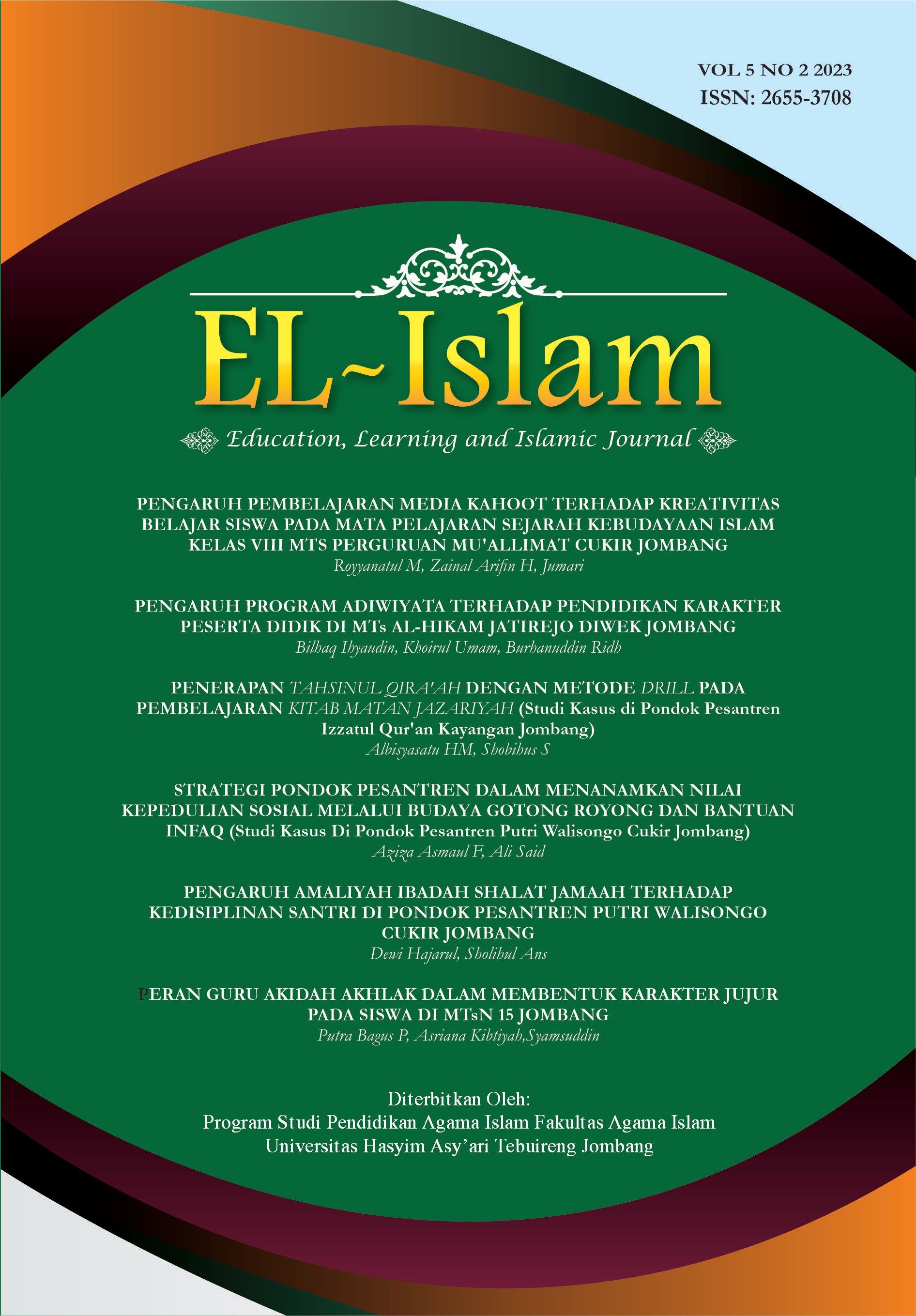PENERAPAN TAHSINUL QIRA’AH DENGAN METODE DRILL PADA PEMBELAJARAN KITAB MATAN JAZARIYAH (Studi Kasus di Pondok Pesantren Izzatul Qur’an Kayangan Jombang)
DOI:
https://doi.org/10.33752/el-islam.v5i2.5145Keywords:
Keyword: Tahsinul Qira'ah, Drill Method, Book of Matan JazariyahAbstract
Abstrac: The purpose of this journal is to review the results of research on the application of tahsinul qiraah with the drill method in learning the book of matan jazariya at the Izzatul Qur'an Kayangan Diwek Jombang Islamic Boarding School. With a qualitative descriptive approach and data collection methods in the form of observation, interviews and documentation. This research has results, namely 1) the application of tahsinul qira'ah with the drill method in the process of reading the Qur'an in the Islamic boarding school izzatul qur'an has differences in each student. In improving the reading of the Qur'an or called tahsinul qira'ah, santri is supported by the application of fashohah in every night. Which fashohah must be followed by all students by understanding makharijul and the nature of letters in reading them. 2) The study of the book of Matan Jazariyah at the Izzatul Qur'an Islamic Boarding School has a very important role in the process of implementing this tahsinul qira'ah. Santri can memorize nadzom in advance in order to practice makharijul grammar and the nature of the letters read in that night. But not only memorized, students can also interpret the book to better understand what is in the book and can immediately be practiced during the fashohah process. 3) The application of tahsinul qira'ah with the drill method in learning the book of matan jazariyah at the Islamic boarding school Izzatul Qur'an has differences in the ability to understand the material that has been delivered by the ustadz and the differences between each student in istiqomah nderes itself every day. Because habituation also has a good influence on the reading of the Qur'an santri. So it cannot be equated between one student and another. Still have differences in ability, of course. However, with the implementation of this application by being carried out istiqomah every day, students have differences in reading the Qur'an and understanding makharijul and the nature of letters. So that with this habituation, students are also not only able to read the Qur'an, but also have their theories in applying to the verses of the Qur'an.
Downloads
References
Daftar Pustaka
Arwani, M Ulil Albab. Kitab Tajwid. Kudus: Mubarokat Thoyyibah, 2019.
Majid, Abdul. Strategi Pembelajaran. Bandung: PT Remaja Rosdakarya, 2015.
Mashuri, Michamad Mukhid. “Peranan Imam Shatibi Dan Ibn Al-Jazari Dalam Ilmu Qiraat (Studi Analisis Historis).” Mafhum 01, no. 01 (2016).
Matapa, Dg, Haerul, and Muhammad Hasan. Pembelajaran Berbasis Riset. Bandung: Media Sains Indonesia, 2021.
Salim, Muslim. Ilmu Nagham Al-Qur’an. Jakarta: PT Kebayoran Widya Ripta, 2004.
Shihab, H Quraish. Tafsir Al-Misbah. Jakarta: Penerbit Lentera Hati, 2002.
Sugiono. Metode Penelitian Kualitatif Dan Kuantitaif Dan R&D. Bandung: ALFABETA, 2019.
Supraha, Wido, Hasbi Indra, and Albadi. “Implementasi Seni Baca Irama Al Qur’an Dalam Metode Pembelajaran Tahsin Al-Qur’an.” Rayah Al-Islam 5, no. 2 (2021)
Yudhi Ardhiana, Dewa Putu. Metode Pembelajaran Guru. Jakarta: Yayasan Kita Menulis, 2021.
















